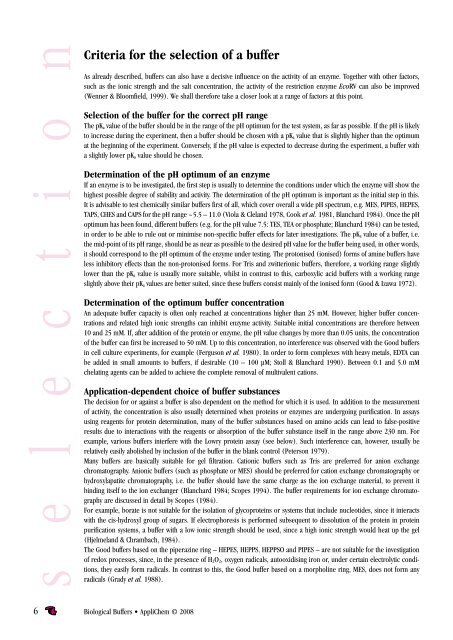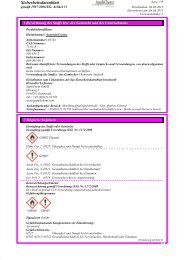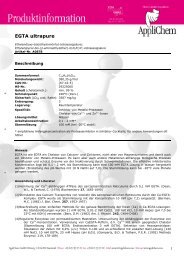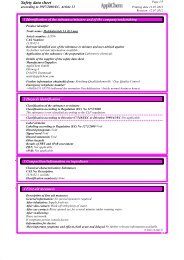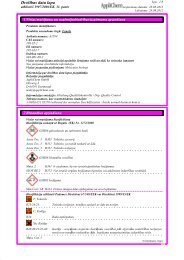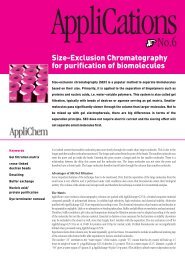Biological Buffers • AppliChem
Biological Buffers • AppliChem
Biological Buffers • AppliChem
Create successful ePaper yourself
Turn your PDF publications into a flip-book with our unique Google optimized e-Paper software.
s e l e c t i o n<br />
Criteria for the selection of a buffer<br />
As already described, buffers can also have a decisive influence on the activity of an enzyme. Together with other factors,<br />
such as the ionic strength and the salt concentration, the activity of the restriction enzyme EcoRV can also be improved<br />
(Wenner & Bloomfield, 1999). We shall therefore take a closer look at a range of factors at this point.<br />
Selection of the buffer for the correct pH range<br />
The pKa value of the buffer should be in the range of the pH optimum for the test system, as far as possible. If the pH is likely<br />
to increase during the experiment, then a buffer should be chosen with a pKa value that is slightly higher than the optimum<br />
at the beginning of the experiment. Conversely, if the pH value is expected to decrease during the experiment, a buffer with<br />
a slightly lower pKa value should be chosen.<br />
Determination of the pH optimum of an enzyme<br />
If an enzyme is to be investigated, the first step is usually to determine the conditions under which the enzyme will show the<br />
highest possible degree of stability and activity. The determination of the pH optimum is important as the initial step in this.<br />
It is advisable to test chemically similar buffers first of all, which cover overall a wide pH spectrum, e.g. MES, PIPES, HEPES,<br />
TAPS, CHES and CAPS for the pH range ~5.5 – 11.0 (Viola & Cleland 1978, Cook et al. 1981, Blanchard 1984). Once the pH<br />
optimum has been found, different buffers (e.g. for the pH value 7.5: TES, TEA or phosphate; Blanchard 1984) can be tested,<br />
in order to be able to rule out or minimise non-specific buffer effects for later investigations. The pKa value of a buffer, i.e.<br />
the mid-point of its pH range, should be as near as possible to the desired pH value for the buffer being used, in other words,<br />
it should correspond to the pH optimum of the enzyme under testing. The protonised (ionised) forms of amine buffers have<br />
less inhibitory effects than the non-protonised forms. For Tris and zwitterionic buffers, therefore, a working range slightly<br />
lower than the pKa value is usually more suitable, whilst in contrast to this, carboxylic acid buffers with a working range<br />
slightly above their pKa values are better suited, since these buffers consist mainly of the ionised form (Good & Izawa 1972).<br />
Determination of the optimum buffer concentration<br />
An adequate buffer capacity is often only reached at concentrations higher than 25 mM. However, higher buffer concentrations<br />
and related high ionic strengths can inhibit enzyme activity. Suitable initial concentrations are therefore between<br />
10 and 25 mM. If, after addition of the protein or enzyme, the pH value changes by more than 0.05 units, the concentration<br />
of the buffer can first be increased to 50 mM. Up to this concentration, no interference was observed with the Good buffers<br />
in cell culture experiments, for example (Ferguson et al. 1980). In order to form complexes with heavy metals, EDTA can<br />
be added in small amounts to buffers, if desirable (10 – 100 µM; Stoll & Blanchard 1990). Between 0.1 and 5.0 mM<br />
chelating agents can be added to achieve the complete removal of multivalent cations.<br />
Application-dependent choice of buffer substances<br />
The decision for or against a buffer is also dependent on the method for which it is used. In addition to the measurement<br />
of activity, the concentration is also usually determined when proteins or enzymes are undergoing purification. In assays<br />
using reagents for protein determination, many of the buffer substances based on amino acids can lead to false-positive<br />
results due to interactions with the reagents or absorption of the buffer substance itself in the range above 230 nm. For<br />
example, various buffers interfere with the Lowry protein assay (see below). Such interference can, however, usually be<br />
relatively easily abolished by inclusion of the buffer in the blank control (Peterson 1979).<br />
Many buffers are basically suitable for gel filtration. Cationic buffers such as Tris are preferred for anion exchange<br />
chro matography. Anionic buffers (such as phosphate or MES) should be preferred for cation exchange chromatography or<br />
hydroxylapatite chromatography, i.e. the buffer should have the same charge as the ion exchange material, to prevent it<br />
binding itself to the ion exchanger (Blanchard 1984; Scopes 1994). The buffer requirements for ion exchange chromatography<br />
are discussed in detail by Scopes (1984).<br />
For example, borate is not suitable for the isolation of glycoproteins or systems that include nucleotides, since it interacts<br />
with the cis-hydroxyl group of sugars. If electrophoresis is performed subsequent to dissolution of the protein in protein<br />
purification systems, a buffer with a low ionic strength should be used, since a high ionic strength would heat up the gel<br />
(Hjelmeland & Chrambach, 1984).<br />
The Good buffers based on the piperazine ring – HEPES, HEPPS, HEPPSO and PIPES – are not suitable for the investigation<br />
of redox processes, since, in the presence of H2O2, oxygen radicals, autooxidising iron or, under certain electrolytic conditions,<br />
they easily form radicals. In contrast to this, the Good buffer based on a morpholine ring, MES, does not form any<br />
radicals (Grady et al. 1988).<br />
6 <strong>Biological</strong> <strong>Buffers</strong> <strong>•</strong> <strong>AppliChem</strong> © 2008


